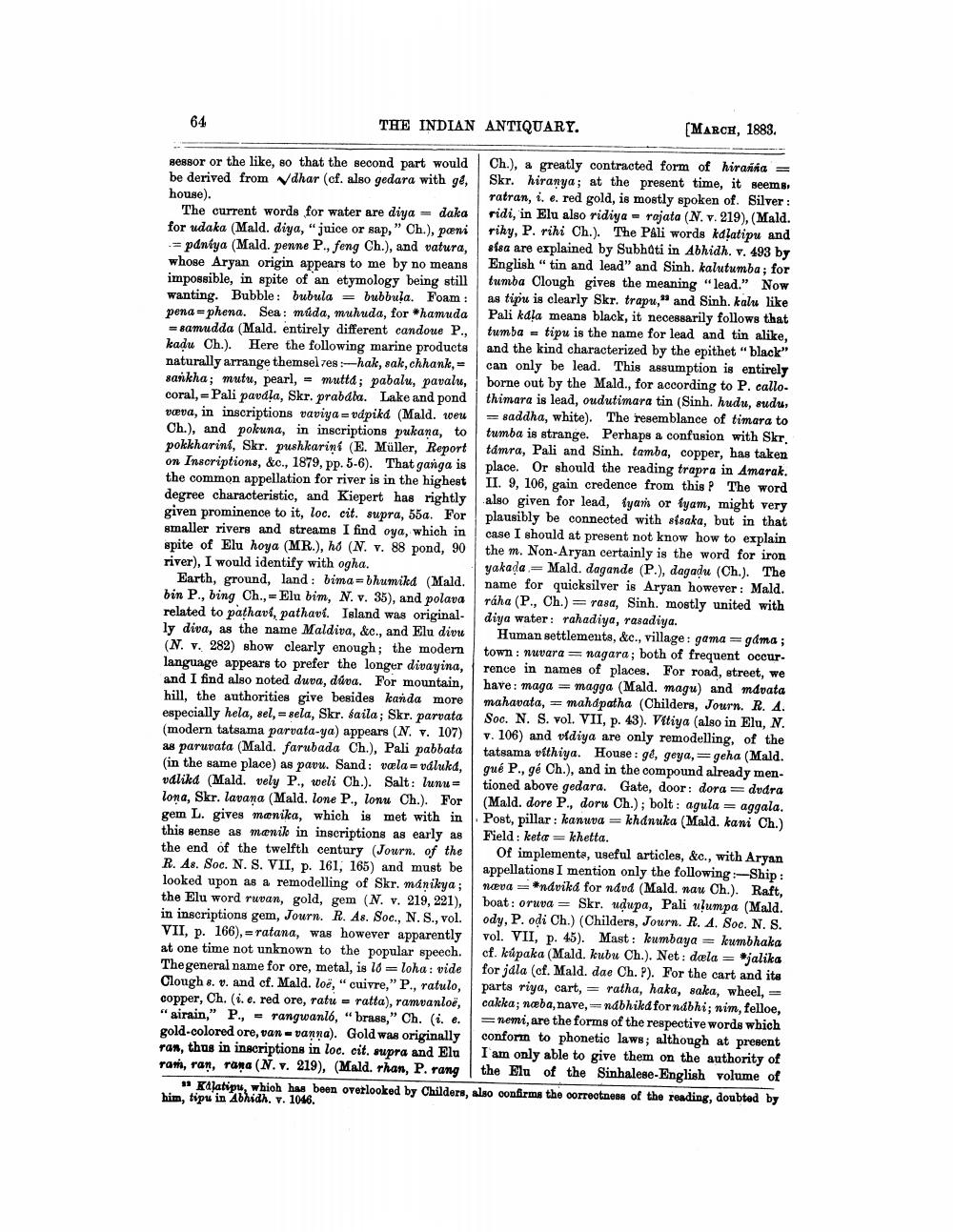________________
64
THE INDIAN ANTIQUARY.
[MARCH, 1883.
Bessor or the like, so that the second part would Ch.), a greatly contracted form of hiranna = be derived from dhar (cf. also gedara with ge, Skr. hiranya; at the present time, it seems. house).
ratran, i. e. red gold, is mostly spoken of. Silver : The current words for water are diya - daka ridi, in Elu also ridiya - rajata (N. v. 219), (Mald. for udaka (Mald. diya, "juice or sap," Ch.), peni riky, P. rihi Ch.). The Pali words kalatipu and - pantya (Mald. penne P., feng Ch.), and vatura, sisa are explained by Subhati in Abhidh. v. 493 by whose Aryan origin appears to me by no means English "tin and lead" and Sinh, kalutumba; for impossible, in spite of an etymology being still tumba Clough gives the meaning "lead." Now wanting. Bubble: bubula = bubbula. Foam : as tipu is clearly Skr. trapu," and Sinh. kalu like pena=phena. Sea: múda, muhuda, for hamuda Pali kala means black, it necessarily follows that
= samudda (Mald. entirely different candoue P., tumba - tipu is the name for lead and tin alike, kadu Ch.). Here the following marine products and the kind characterized by the epithet "black" naturally arrange themselves :-hak, sak, chhank, can only be lead. This assumption is entirely sarkha; mutu, pearl, = mutta; pabalu, pavals, borne out by the Mald., for according to P. callo. coral, = Pali pavdla, Skr. prabdba. Lake and pond thimara is lead, oudutimara tin (Sinh, hudu, sudu, vova, in inscriptions vaviya = vdpikd (Mald. were = saddha, white). The resemblance of timara to Ch.), and pokuna, in inscriptions pukana, to tumba is strange. Perhaps a confusion with Skr. pokkharini, Skr. pushkarini (E. Müller, Report támra, Pali and Sinh, tamba, copper, has taken on Inscriptions, &c., 1879, pp. 5-6). That ganga is place. Or should the reading trapra in Amarak. the common appellation for river is in the highest II. 9, 106, gain credence from this P The word degree characteristic, and Kiepert has rightly also given for lead, iyan or Syam, might very given prominence to it, loc. cit. supra, 55a. For plausibly be connected with sisaka, but in that smaller rivers and streams I find oya, which in case I should at present not know how to explain spite of Elu hoya (MR.), hó (N. v. 88 pond, 90 the m. Non-Aryan certainly is the word for iron river), I would identify with ogha.
yakada = Mald. dagande (P.), dagadu (Ch.). The Earth, ground, land: bima=bhumika (Mald. name for quicksilver is Aryan however : Mald. bin P., bing Ch., - Elu bim, N. v. 35), and polava ráha (P., Ch.)=rasa, Sinh. mostly united with related to pathavi, pathaví. Island was original- diya water: rahadiya, rasadiya. ly diva, as the name Maldiva, &c., and Elu divu Human settlements, &c., village: gama=gama; (N. v. 282) show clearly enough; the modern town: wuvara = nagara; both of frequent occur. language appears to prefer the longer divayina, rence in names of places. For road, street, we and I find also noted duva, dúva. For mountain, have: maga = magga (Mald. magu) and mdvata hill, the authorities give besides kanda more mahavata, = mahapatha (Childers, Journ. R. 4. especially hela, sel, = sela, Skr. Saila; Skr. parvata Soc. N. S. vol. VII, p. 43). Vitiya (also in Elu, N. (modern tatsama parvata-ya) appears (N. v. 107) v. 106) and vidiya are only remodelling, of the as paruvata (Mald. farubada Ch.), Pali pabbata tatsama vsthiya. House : gé, geya,=geha (Mald. (in the same place) as pavu. Sand: vala- vdluka, qué P., gé Ch.), and in the compound already men válika (Mald. vely P., weli Ch.). Salt: lunu= tioned above gedara. Gate, door: dora=dvdra lona, Skr. lavana (Mald. lone P., lonu Ch.). For (Mald. dore P., doru Ch.); bolt: agula = aggala. gem L. gives monika, which is met with in Post, pillar : kanuva khanuka (Mald, kani Ch.) this sense as monil in inscriptions as early as Field : keta = khetta. the end of the twelfth century (Journ. of the Of implemente, useful articles, &c., with Aryan R.As. Soc. N. S. VII, p. 161, 165) and must be appellations I mention only the following:-Ship : looked upon as a remodelling of Skr. manikya; næva =*ndvika for ndvd (Mald. nau Ch.). Raft, the Elu word ruvan, gold, gem (N. v. 219, 221), boat: oruva = Skr. udupa, Pali ulumpa (Mald. in inscriptions gem, Journ. R. As. Soc., N. S., vol. ody, P. odi Ch.) (Childers, Journ. R. A. Soc. N. S. VII, p. 166), = ratana, was however apparently vol. VII, p. 45). Mast: kumbaya = kumbhaka at one time not unknown to the popular speech. cf. kúpaka (Mald. kubu Ch.). Net: dæla = "jalika Thegeneral name for ore, metal, is 18 = loha: vide for jdla (cf. Mald. dae Ch.P). For the cart and its Clough 8. v. and cf. Mald. loë, "cuivre," P., ratulo, parts riya, cart, = ratha, haka, saka, wheel, copper, Ch.(i.e. red ore, ratu = ratta), ramvanloë, cakka; næba, nave,=ndbhikd for nábhi; nim, felloe, "airain," P., = rangwanló, "brass," Ch. i. e. | Enemi, are the forms of the respective words wbich gold-colored ore, van-vanna). Gold was originally conform to phonetic laws; although at present ran, thus in inscriptions in loc. cit. supra and Elu I am only able to give them on the authority of ran, ran, rana (N. v. 219), (Mald. Than, P. rang | the Elu of the Sinhalese-English volume of
Kajatipu, which has been overlooked by Childers, also confirms the correctness of the reading, doubted by him, tipu in Abhidh. v. 1046.




